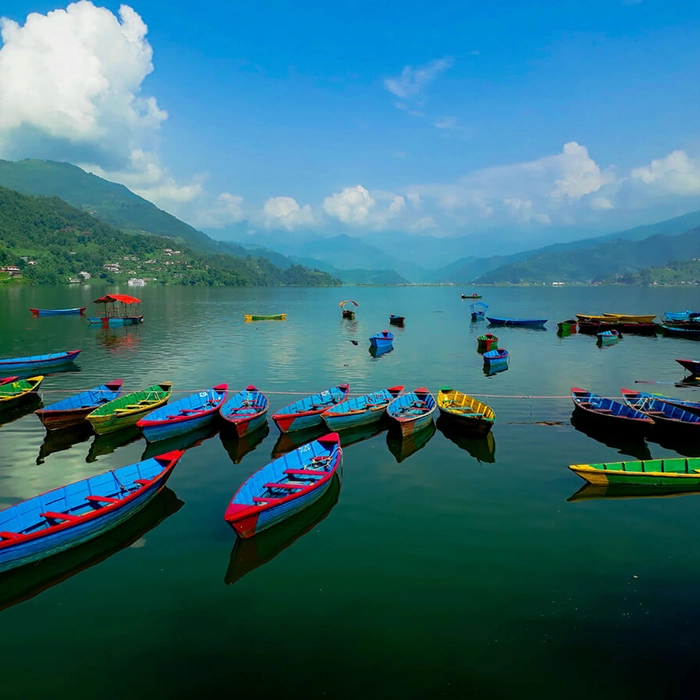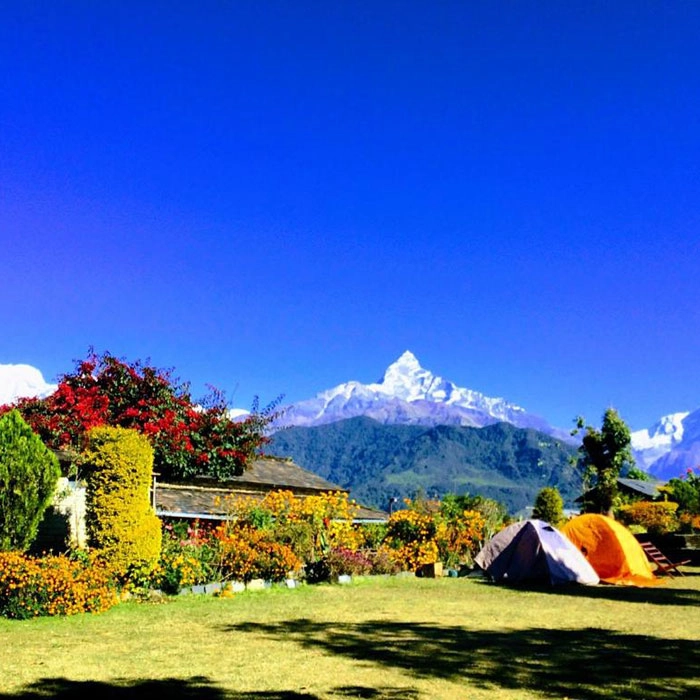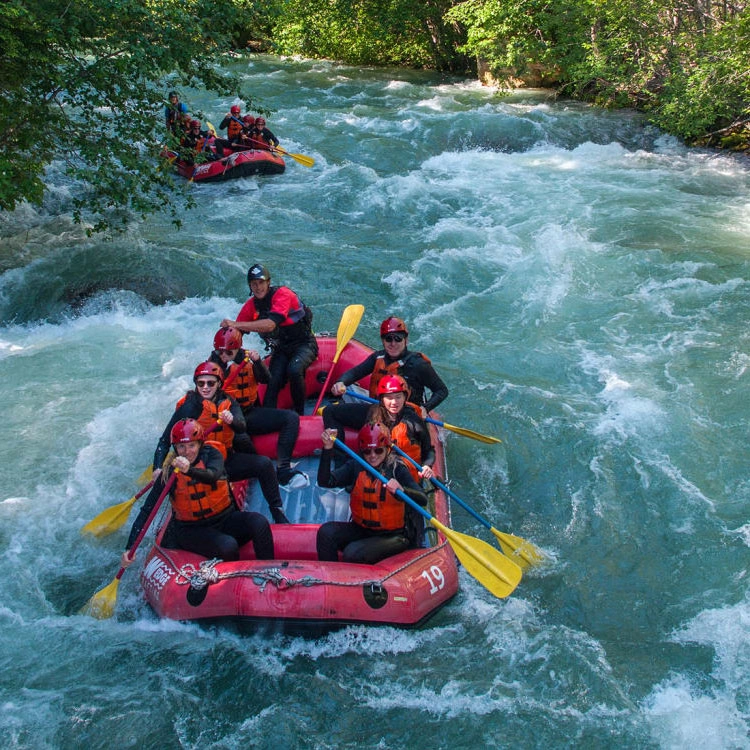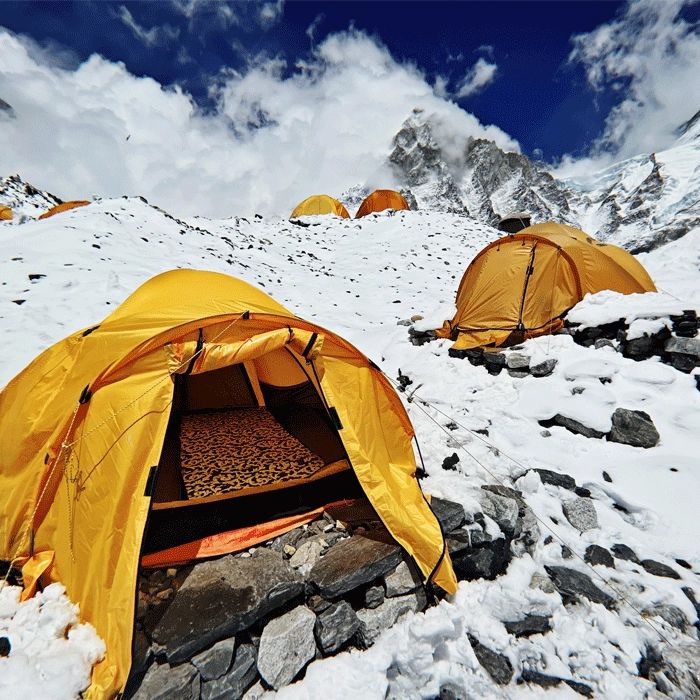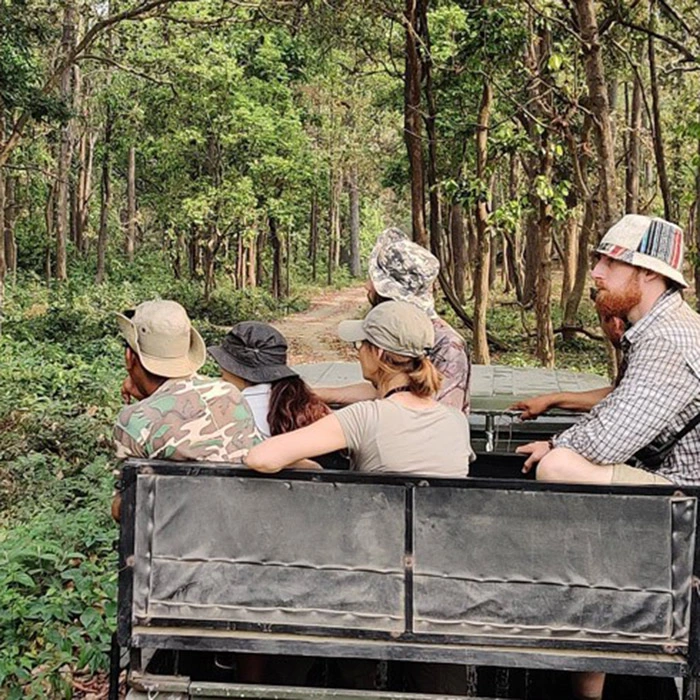GREAT LANGTANG TREK
US$1,800.00
/pp
-
17 Days
-
Langtang
-
Spring/Autumn
-
Trekking
-
4,985 Meters
-
Moderate
-
Jeep / Bus
-
01-16 People
-
JH#241
 Overviews
Overviews
Experience ultimate adventure with the Great Langtang Trek, offering breathtaking landscapes, sacred lakes, and vibrant local culture. This comprehensive trek merges the stunning beauty of the Langtang Valley Trek, the spiritual allure of the Gosainkunda Lake Trek, and the cultural richness of the Helambu Trek, providing an unforgettable trekking experience. The Langtang Valley Trek starts from Syabrubesi, where you’ll traverse lush forests and traditional Tamang villages. Enjoy awe-inspiring views of Langtang Lirung (7,227 meters) and explore Kyanjin Gompa, an ancient monastery nestled in the valley. This part of the trek showcases the stunning scenery and serene environment of Langtang, making it a photographer’s paradise. Next, the Gosainkunda Lake Trek leads to the sacred Gosainkunda Lake, situated at 4,380 meters. Revered by Hindus and Buddhists, this glacial lake is surrounded by dramatic peaks and offers an opportunity for spiritual reflection. The pristine beauty and high-altitude environment make it a memorable destination for trekkers. The adventure concludes with the Helambu Trek, which takes you through Sherpa and Hyolmo villages. This trek provides a unique cultural experience, with lush forests, terraced fields, and panoramic views of the Jugal Himal range. It’s a fantastic way to experience local traditions, hospitality, and natural beauty. Spring and autumn are ideal for trekking, offering clear skies and moderate temperatures. Summer brings lush greenery but also the risk of slippery trails due to monsoon rains, while winter provides snow-covered landscapes and fewer trekkers. Despite the 2015 earthquake, the local communities have diligently restored the infrastructure, ensuring a safe and enriching experience. The Great Langtang Trek delivers an unparalleled trekking adventure, blending dramatic landscapes, rich cultural encounters, and breathtaking natural beauty. It’s a must-do for trekkers seeking both adventure and immersive cultural experiences in Nepal. Great Langtang Trek DifficultyThe Great Langtang Trek is a moderately challenging 14-day Himalayan adventure, well-suited for trekkers with good physical fitness and proper acclimatization. Covering around 70–90 km, the trail takes you through dense forests, steep ascents and descents, rocky paths, and glacial moraines, showcasing both natural beauty and cultural richness.
Trekkers typically walk 4–7 hours per day, depending on the altitude and destination for that stage of the trek. The journey reaches its highest point at 4,985 meters (Tsergo Ri or Kyanjin Ri), where acclimatization and steady pacing are essential to avoid altitude-related symptoms.
Although less demanding than the Everest Base Camp Trek or Annapurna Circuit, the Langtang Trek remains highly rewarding, offering dramatic Himalayan landscapes, panoramic mountain views, and authentic encounters with Tamang and Sherpa culture. Great Langtang Trek CostThe Great Langtang Trek in Nepal requires two national park permits and a TIMS card, totaling approximately USD 70. Beyond permits, the overall trek cost depends on your choice of transport, accommodation, meals, guides, and porter services. Expenses vary based on the level of comfort, service packages, and the mode of travel to reach the trek’s starting point and return to Kathmandu.
Many trekkers opt for a private 4WD jeep from Kathmandu to Syabrubesi, which costs around USD 175, offering a faster and more comfortable alternative to local buses, especially for those heading to remote trekking areas.
Accommodation is available in tea houses along the trail, ranging from basic to moderate, with some offering luxury rooms where available. Room costs typically range from USD 10–30 per night, increasing slightly in higher or more remote locations.
Food and drinks vary depending on the lodge and location. Meals generally cost USD 3–12 per item, bottled water around USD 4 per liter, and hot beverages like tea and coffee USD 2–3 per cup. Menus are often more limited in higher-altitude villages.
 Itinerary (Plan)
Itinerary (Plan)
Arrive in Kathmandu (1,400 m / 4,593 feet), Nepal's vibrant capital, where you'll be warmly welcomed with marigold garlands. After transferring to your hotel, take time to relax and acclimate to the bustling city. Discover vibrant local markets, indulge in traditional Nepali dishes, and delve into Kathmandu's rich cultural tapestry. This initial day is perfect for easing into your journey, setting the stage for the exciting adventures ahead in Eastern Nepal. A representative from Jagadamba Holidays will ensure a smooth and pleasant arrival.
Optional Evening Activity:
If you wish, you can spend your evening experiencing the Pashupatinath Aarti, a captivating religious ceremony held at the Pashupatinath Temple. The Aarti usually begins around 6:00 PM and lasts for approximately an hour. This ceremony is a mesmerizing display of traditional music and rituals, providing a profound insight into Hindu spiritual practices. Please check the exact time for the Aarti on the day of your visit, as it may vary. This option is not included in the standard itinerary but offers a unique opportunity to immerse yourself in local culture.
Embark on a scenic drive from Kathmandu to Syabrubesi, a vibrant village at the gateway of the Langtang region. The journey begins early, as you leave the bustling capital behind and head into the serene countryside. The journey from Kathmandu to Syabrubesi by jeep covers 122 kilometers and takes around 7 hours . The drive takes you through lush green hills, terraced farmlands, and picturesque villages, offering a glimpse into the rural lifestyle of Nepal. As the road winds alongside the Trishuli River, you'll be treated to stunning views of Ganesh Himal, Langtang Lirung, and other Himalayan peaks.
The journey also passes through charming towns like Trishuli Bazaar and Dhunche, where you can stop for refreshments and soak in the local culture. The final stretch involves navigating winding mountain roads, adding an element of adventure to the drive. Upon arrival in Syabrubesi, a bustling hub for trekkers, you can explore the village, interact with locals, and prepare for the trek ahead. The welcoming atmosphere of Syabrubesi sets the perfect tone for your upcoming adventure into the Langtang Valley.
Start your Great Langtang Trek with a hearty breakfast at your lodge in Syabrubesi before embarking on the scenic Syabrubesi to Sherpagaon trek. The trail begins with a steep uphill climb to the traditional Tamang village of Khangjim (2,280 m / 7,480 ft.), taking roughly three hours through dense forests, terraced fields, and picturesque landscapes. Along the way, enjoy mesmerizing views of the Langtang River, terraced farmland, and surrounding Himalayan peaks, making this an immersive Himalayan adventure.
Upon reaching Khangjim, you can rest and interact with locals, experiencing the vibrant culture and hospitality of the Tamang people. From Khangjim, the trek continues with a gentler ascent, winding through lush forests, crossing sparkling mountain streams, and offering uninterrupted views of the Langtang Valley and its dramatic peaks.
The journey covers approximately 10.1 kilometers, with an ascent of 1,300 meters and a descent of 190 meters, typically taking 5 to 6 hours. As you approach Sherpagaon (2,563 m / 8,409 ft.), perched on a scenic ridge, you are rewarded with panoramic vistas of the Nepal Himalayas, making it the perfect spot to relax and soak in the serene mountain atmosphere.
This trek is ideal for travelers seeking a blend of adventure, culture, and Himalayan scenery. From the charm of rural Tamang villages to breathtaking mountain panoramas, the Syabrubesi to Sherpagaon trek offers an unforgettable Langtang Valley trekking experience in Nepal.
After a hearty breakfast at your lodge in Sherpagaon, set out on the scenic Sherpagaon to Thangsyap trek, part of the renowned Great Langtang Trek in Nepal. This beautiful route passes through key villages like Lama Hotel (2,480 m / 8,136 ft.) and Ghodatabela (3,030 m / 9,941 ft.), offering travelers an authentic glimpse into the daily life of the Tamang communities of the Langtang Valley.
The trek spans approximately 11.6 kilometers, with an ascent of 810 meters and a descent of 200 meters, typically taking 5 to 6 hours. The trek winds through lush oak, pine, and rhododendron forests, offering chances to spot Himalayan wildlife including red pandas, langurs, and rare birds. Following the Langtang River, the trail crosses several suspension bridges and passes small settlements like Rimche and Bamboo, giving trekkers a chance to experience local culture while enjoying stunning natural surroundings.
As you ascend, the path opens to panoramic views of the Langtang Valley and snow-capped Himalayan peaks, providing perfect opportunities for photography and nature appreciation. Nearing Thangsyap (3,140 m / 10,433 ft.), you will find lush meadows, terraced fields, and a serene mountain village, ideal for an overnight stay.
This Thangsyap trekking route is perfect for travelers seeking a blend of adventure, culture, and Himalayan scenery. From Langtang Valley trekking and wildlife spotting to interacting with Tamang villages, this journey delivers a full Nepal trekking experience. The Sherpagaon to Thangsyap trek is a highlight of the Great Langtang Trek, promising breathtaking landscapes, cultural immersion, and unforgettable Himalayan adventures.
After a hearty breakfast at your lodge, begin your trek toward Kyanjin (3,830 m / 12,566 ft.), one of the key highlights of the Great Langtang Trek in Nepal. Today’s journey offers breathtaking views of towering Himalayan peaks and a poignant glimpse of the Langtang village, which was affected by past natural disasters, adding historical and emotional depth to your adventure.
The trail spans approximately 10.5 kilometers, typically taking 4 to 5 hours, with an ascent of 720 meters and a descent of 50 meters. Moderate ascents allow trekkers to fully enjoy the surrounding landscapes. The route winds through lush forests of pine, oak, and rhododendron, passes terraced fields, and follows meandering streams, offering an immersive experience in the heart of the Himalayas. Breathtaking views of Langtang Lirung (7,227 m / 23,711 ft.) and surrounding snow-capped peaks offer ideal spots for photography and soaking in the Himalayan scenery.
Along the way, trekking through traditional Tamang villages, you can observe stone-built houses, terraced farmlands, and local daily life, offering a rich cultural experience. Kyanjin is a peaceful mountain village nestled amid the dramatic Himalayan peaks, offering a serene retreat to relax and take in the stunning surroundings. The village is home to the Kyanjin Gumba, a historic Buddhist monastery, making it both culturally and scenically significant.
Reaching Kyanjin represents the first major destination of the Great Langtang Trek, offering travelers a sense of accomplishment and a chance to acclimatize while enjoying the beauty of the Himalayas. This stage combines adventure, culture, and natural splendor, making an overnight stay in Kyanjin both relaxing and inspiring. From panoramic mountain views to immersive cultural encounters, Kyanjin sets the tone for the unforgettable journey ahead, including the trek toward Gosainkunda, the next major highlight.
Begin your Tserko Ri Trek early to experience breathtaking Himalayan panoramas and maximize your adventure. Starting from Kyangjin Gompa (3,870 m / 12,697 ft.), this trek offers one of the most rewarding high-altitude experiences in Nepal. With no tea houses along the trail, make sure to carry breakfast, lunch, and plenty of water. Alternatively, you can enjoy a relaxed day in the serene village of Kyangjin Gompa, surrounded by stunning Himalayan peaks—a perfect opportunity for acclimatization, rest, and photography. For adventure seekers, the challenging and scenic Tserko Ri hike is highly recommended.
The trek follows a steep trail for approximately 5–6 hours one way, winding through vibrant alpine meadows and yak pastures. Along the way, enjoy spectacular views of Langtang Lirung (7,227 m / 23,711 ft.), Langshisa Ri (6,427 m / 21,086 ft.), and neighboring snow-capped peaks. As you ascend, the trail becomes steeper and the air thinner, intensifying the challenge and making the summit an exceptionally rewarding accomplishment.
At the summit of Tserko Ri (4,985 m / 16,355 ft.), trekkers are rewarded with panoramic vistas of the Langtang Valley, glaciers, and the Himalayan range stretching toward Tibet. This nearly 5,000-meter vantage point is perfect for photography and offers an unforgettable high-altitude adventure. The descent back to Kyangjin Gompa typically takes 2–3 hours.
For those seeking a more relaxed day, Kyangjin Gompa provides the chance to explore the village, visit the local cheese factory, or simply soak in the tranquil Himalayan surroundings. Whether hiking to Tserko Ri or enjoying the village, this itinerary blends adventure trekking, cultural immersion, and nature exploration.
The round-trip distance to Tserko Ri is 9.6 kilometers, with a total duration of 7–9 hours, including an ascent and descent of 1,090 meters—offering a perfectly balanced and rewarding Himalayan trekking experience in Nepal’s Langtang Valley.
Begin your day with an unforgettable sunrise hike to Kyangjin Ri (4,779 m / 15,679 ft.), one of the most celebrated viewpoints in the Langtang Valley, offering unparalleled Himalayan panoramas. This short yet rewarding trek covers approximately 2.48 kilometers round trip and typically takes 2–3 hours to complete, with an ascent and descent of 380 meters.
As you ascend through the crisp morning air, anticipation intensifies for the sweeping Himalayan vistas that await at the summit. When the first rays of sunlight illuminate the snow-clad peaks, the Langtang Himal range comes alive in shades of gold and crimson—a perfect moment for photography and quiet reflection. From the summit, you can admire sweeping vistas of Langtang Lirung, surrounding glaciers, and the serene valley below. After savoring the scene, descend back to Kyangjin Gompa for a hearty breakfast.
Following this breathtaking start, continue your journey by trekking from Kyangjin Gompa to Lama Hotel (2,480 m / 8,136 ft.). The route retraces your steps along the Langtang Valley trail, spanning 18.4 kilometers over 6–7 hours. On this section, you will ascend approximately 50 meters and descend around 1,420 meters, making it a predominantly downhill journey that’s easier on the lungs but still engaging for the legs.
This return trek offers a fresh perspective on the landscapes you passed earlier—lush rhododendron and oak forests, charming Tamang settlements, and the glistening Langtang River running alongside the path. The trek offers opportunities to encounter Himalayan wildlife, including langurs, elusive red pandas, and a variety of colorful bird species.
As the gentle rustling of leaves and the sound of the flowing river accompany your descent, you’ll feel a sense of calm and connection to nature. Upon reaching Lama Hotel, you’ll be welcomed into a warm, rustic atmosphere, perfect for relaxing and reflecting on a day that seamlessly blended high-altitude adventure with natural serenity.
After breakfast at the lodge, begin your scenic trek from Lama Hotel along the picturesque Langtang River, passing through the charming settlement of Bamboo (1,970 m / 6,463 ft.). This route offers trekkers a captivating introduction to the Langtang Valley, with lush forests, traditional villages, and peaceful riverside trails. The journey highlights include walking through rhododendron, oak, and bamboo groves, observing the natural harmony of the Himalayan landscape, and enjoying serene moments by the Langtang River. Small villages like Pairo and Bamboo provide opportunities to interact with the local Tamang community and experience authentic Himalayan culture.
The trek from Lama Hotel to Thulo Syabru spans approximately 9.96 kilometers and typically takes 5–6 hours to complete, offering trekkers an immersive Himalayan trekking experience. Trekkers will ascend 490 meters and descend 780 meters along this route, making it a moderate trek suitable for those who wish to experience both the thrill of the ascent and the tranquility of the descent. The combination of gradual elevation changes and varied terrain ensures an engaging and fulfilling trekking experience in the heart of Nepal’s Himalayas.
As you approach Thulo Syabru (2,250 m / 7,382 ft.), the landscape opens to panoramic views of the Ganesh Himal range, terraced farmlands, and surrounding valleys. Thulo Syabru is a scenic hillside Tamang village, renowned for its traditional stone houses, vibrant cultural heritage, and stunning Himalayan sunset views. This trail offers more than just scenic beauty—it provides an immersive experience in local life, from observing traditional farming practices to spotting Himalayan wildlife and vibrant flora along the way. The route’s natural beauty, cultural significance, and peaceful atmosphere make it a highlight of the Langtang Valley trek, offering trekkers an unforgettable adventure and perfect photo opportunities.
After breakfast at the lodge, begin your scenic trek from Thulo Syabru to Shin Gompa (3,330 m / 10,925 ft.), passing through the picturesque route of Phoprang Danda (3,150 m / 10,335 ft.). This trail offers trekkers a captivating introduction to higher Himalayan altitudes, with pine and rhododendron forests, traditional settlements, and sacred chortens adorned with colorful prayer flags. Along the way, enjoy occasional glimpses of the snow-capped Langtang and Ganesh Himal ranges, providing serene moments and excellent photography opportunities.
The trek from Thulo Syabru to Shin Gompa spans approximately 6.76 kilometers and typically takes 4–5 hours to complete, offering trekkers a rewarding high-altitude trekking experience. Along this route, trekkers will ascend 1,120 meters and descend 40 meters, combining a challenging climb with gentle sections that allow time to appreciate the pristine Himalayan landscape. The steady ascent through lush forests ensures a balanced trekking experience suitable for adventure seekers and nature enthusiasts alike.
As you approach Shin Gompa, also known as Chandanbari, the surroundings open to spectacular panoramic views of the surrounding peaks. Shin Gompa is home to an ancient monastery and a renowned yak cheese factory, where visitors can sample locally produced cheese and learn about traditional Himalayan cheese-making practices. This trail offers more than just breathtaking scenery—it provides a deep cultural immersion, encounters with local communities, and the chance to experience the unique harmony of nature and tradition in the Langtang Valley, making it a highlight of your Himalayan adventure.
After breakfast at the lodge, begin your scenic trek from Shin Gompa toward Laurebina, following the picturesque trail through Cholang Pati (3,620 m / 11,875 ft.). This trek takes you through the stunning high-altitude landscapes of the Langtang Valley, winding past dense alpine forests, open meadows, and traditional sacred sites. Along the way, you can admire the vibrant Himalayan flora, pause at chortens adorned with colorful prayer flags, and enjoy serene moments immersed in the crisp, refreshing mountain air. The journey highlights the region’s natural beauty and cultural richness, providing an immersive Himalayan trekking experience.
The trek from Shin Gompa to Laurebina (3,910 m / 12,828 ft.), spans approximately 5.42 kilometers and typically takes 3–4 hours to complete. Trekkers will ascend 620 meters and descend 30 meters along this trail, offering a gradual climb that allows for effective acclimatization while enjoying the stunning scenery. This moderate trek combines steady elevation gain with a manageable distance, making it suitable for trekkers aiming to reach higher altitudes while maintaining comfort and energy for the next stage of the adventure.
As you approach Laurebina (3,910 m / 12,828 ft.), the landscape opens to breathtaking panoramic views of the surrounding Himalayan ranges, including Annapurna and Manaslu to the west and the Langtang range to the east. Laurebina is a small, ridge-top settlement that provides a perfect vantage point for photography and reflection. Its strategic location makes it an ideal stop for acclimatization before continuing your trek to Gosainkunda Lake. The combination of cultural landmarks, alpine scenery, and tranquil high-altitude environment makes this route an essential highlight of the Langtang and Gosainkunda trekking circuit.
After breakfast at the lodge, begin your scenic trek from Laurebina toward Gosainkunda Lake, following the picturesque trail that passes by Buddha Mandir and Ganesh Temple. This high-altitude trek takes you through the stunning Himalayan landscapes of the Langtang region, with rocky trails, alpine meadows, and sacred landmarks enriching the journey. Along the way, notice the vibrant Himalayan flora, pause at prayer-flag-adorned cairns, and enjoy tranquil moments surrounded by crisp mountain air. The route highlights both the natural beauty and spiritual significance of the region, offering an immersive and rewarding Himalayan trekking experience.
The trek from Laurebina to Gosainkunda Lake spans approximately 3.56 kilometers and typically takes 2–3 hours to complete. Trekkers will ascend 480 meters and descend 10 meters along this trail, providing a gradual climb that supports acclimatization while allowing you to fully enjoy the dramatic surroundings. The moderate distance combined with steady elevation gain makes this segment suitable for trekkers aiming to reach one of Nepal’s most iconic high-altitude lakes comfortably and safely.
As you approach Gosainkunda Lake (4,380 m / 14,370 ft.), the landscape opens to breathtaking panoramas of surrounding snow-capped peaks mirrored in the lake’s crystal-clear waters. This sacred site holds immense religious significance for both Hindus and Buddhists, with nearby lakes such as Saraswati Kunda and Bhairav Kunda adding to the spiritual atmosphere. Spend time exploring the serene environment, capturing memorable photographs, and soaking in the peaceful ambiance of this high-altitude Himalayan gem. The combination of cultural landmarks, alpine scenery, and tranquil high-altitude environment makes this segment a highlight of the Langtang and Gosainkunda trekking circuit.
After enjoying breakfast at your lodge, begin your scenic trek from Laurebina toward Ghopte, following the trail that passes over the iconic Laurebina La Pass (4,610 m / 15,125 ft.). This high-altitude route offers trekkers a remarkable experience of the Langtang Valley’s alpine landscapes, traversing rocky ridges, pristine meadows, and sacred sites along the way. As you ascend toward the pass, take in the crisp mountain air, vibrant flora, and dramatic vistas of the surrounding Himalayan peaks. The trail provides numerous opportunities for photography and moments of reflection amid the breathtaking natural scenery.
The trek from Gosainkunda Lake to Ghopte via Laurebina La Pass covers approximately 11.5 km and typically takes 6–7 hours, offering breathtaking Himalayan views along the route. Trekkers will ascend 400 meters and descend 1,410 meters during this journey, making it a physically rewarding yet manageable route. The combination of steady ascent, challenging descent, and varied terrain ensures a comprehensive high-altitude trekking experience, ideal for those seeking both adventure and acclimatization in the Langtang region.
The highlight of today’s trek is crossing Laurebina La Pass, which opens up panoramic views of the surrounding Himalayan ranges, valleys, and snow-capped peaks. From the pass, the trail descends steeply through rugged terrain, passing isolated alpine meadows, scattered rock formations, and dense forests that are home to diverse Himalayan wildlife. Eventually, the trail leads to the serene settlement of Ghopte (3,430 m / 12,253 ft.), where trekkers can rest and immerse themselves in the peaceful mountain surroundings. This route combines the thrill of high-altitude trekking, spectacular landscapes, and cultural richness, making it one of the most rewarding experiences on the Great Langtang Trek.
After your breakfast at the lodge, begin your scenic trek from Ghopte toward Kutumsang, following the picturesque route that includes Tharepati (3,690 m / 12,106 ft.). This trek takes you through diverse Himalayan landscapes, including dense forests, open ridges, and traditional Tamang villages. Along the trail, you can admire vibrant alpine flora, pause at scenic viewpoints, and enjoy tranquil moments surrounded by the crisp mountain air. The route highlights the natural beauty and cultural richness of the Langtang region, offering an immersive Himalayan trekking experience.
The trek from Ghopte to Kutumsang spans approximately 14 kilometers and typically takes 6–7 hours to complete. Trekkers will ascend 450 meters and descend 1,380 meters along this trail, providing a balanced mix of gradual climbs and descents. This moderate-to-challenging trek allows trekkers to experience both the thrill of the ascent to Tharepati and the serenity of descending through lush forests while enjoying panoramic Himalayan views.
As you approach Kutumsang (2,470 m / 8,104 ft.), the landscape opens to breathtaking vistas of the surrounding Langtang Himalayas. Kutumsang is a peaceful hillside settlement with traditional stone houses, offering stunning sunset views over the mountains. The trail provides opportunities to observe local wildlife, interact with the Tamang community, and experience authentic Himalayan culture. This route’s combination of scenic beauty, cultural significance, and diverse terrain makes it a memorable and essential stage of the Great Langtang Trek.
After enjoying breakfast at the lodge in Kutumsang, begin your scenic trek toward Chisapani (2,165 m / 7,103 ft.), following a picturesque trail that passes through Lapse Danda. The route winds through a variety of landscapes, including terraced fields, dense oak and rhododendron forests, and small, traditional Tamang villages. Along the way, trekkers can observe local flora and fauna, interact with the welcoming mountain communities, and capture the serene beauty of the Langtang region. The trail showcases the seamless blend of terraced farmlands and pristine Himalayan landscapes, offering trekkers a truly immersive adventure.
The trek from Kutumsang to Chisapani via Lapse Danda spans approximately 16.7 kilometers and typically takes 7–8 hours to complete, offering breathtaking Himalayan views and immersive cultural experiences. Trekkers will ascend 920 meters and descend 1,220 meters along this route. The combination of moderate ascents and descents, along with the varied terrain, offers both a physical challenge and an opportunity to enjoy the breathtaking scenery at a comfortable pace. This segment of the trek ensures gradual acclimatization while keeping energy levels for the remaining journey.
As you approach Chisapani, the landscape opens to sweeping panoramic views of the Langtang and Jugal Himal ranges. Chisapani itself is a serene mountain settlement, known for its tranquil environment and spectacular viewpoints. The village offers an ideal setting for rest and reflection after a full day of trekking, with majestic Himalayan peaks in the distance and a peaceful atmosphere that allows trekkers to connect deeply with the region’s natural beauty. This trail, combining cultural interaction, alpine forests, and expansive mountain vistas, remains a highlight of the Langtang Valley trekking experience, perfect for photography and memorable adventure moments.
After breakfast at the lodge, begin your final trek from Chisapani toward Sundarijal, following the scenic trail that passes through Mulkharka (1,855 m / 6,086 ft.). This route takes you through diverse landscapes, from terraced farmland to lush forested areas, allowing trekkers to soak in the natural beauty of the Langtang region one last time. Along the way, observe local villages, interact with friendly Nepali communities, and enjoy panoramic views of the surrounding valleys and distant Himalayan peaks. The trail highlights the harmony between rural life and the pristine environment, offering an immersive cultural and nature experience.
The trek from Chisapani to Sundarijal spans approximately 9.7 kilometers and typically takes 4–5 hours to complete. Trekkers will ascend 260 meters and descend 1,030 meters along this journey, making it a gentle yet rewarding final day of trekking. The combination of gradual climbs and long descents provides a comfortable route for concluding your trek while still enjoying the invigorating Himalayan terrain.
As you approach Sundarijal (1,460 m / 4,790 ft.), the trail winds through the verdant forests of Shivapuri National Park, home to rich flora and fauna. Passing through small Nepali villages and scenic terraced farmlands, trekkers gain a final glimpse of the tranquility and charm of rural Himalayan life. Upon reaching Sundarijal, a short drive returns you to the bustling city of Kathmandu (1,400 m / 4,593 feet). This last leg of the trek perfectly blends adventure, nature, and culture, concluding your Langtang trekking journey with lasting memories of Nepal’s mountains, landscapes, and local heritage.
The buffer day in Kathmandu serves as a crucial safety net during your trekking adventure in the Himalayas. Given the unpredictable nature of mountain weather and the potential for flight delays, this day is designed to ensure a smooth travel experience. By including a buffer day in your itinerary, you can mitigate the impact of unforeseen circumstances and allow for a more relaxed journey.
If your flights operate as scheduled and weather conditions are favorable, this day offers a fantastic opportunity to explore the rich cultural and historical tapestry of the Kathmandu Valley. The valley is a UNESCO World Heritage Site, home to seven remarkable monument zones, each showcasing unique aspects of Nepalese culture and heritage.
You can begin your exploration in the heart of Kathmandu at Durbar Square, where ancient palaces, temples, and courtyards tell the story of the city's royal history. Marvel at the intricately carved architecture of Kastamandap and Kasthamandap Temple, and don’t miss the iconic Kumari Ghar, the residence of the living goddess, or Kumari.
Next, consider visiting Swayambhunath, also known as the Monkey Temple, perched atop a hill overlooking the valley. This ancient stupa is adorned with colorful prayer flags and offers panoramic views of the city and surrounding mountains. The site is also home to many monkeys, adding a playful element to your visit.
For a more spiritual experience, you can head to Boudhanath Stupa, one of the largest stupas in the world. This sacred site is a significant pilgrimage destination for Buddhists and features a bustling marketplace filled with traditional shops and eateries. Here, you can observe the rituals of local monks and engage with the community while enjoying a delicious bowl of traditional Nepali dal bhat.
If you have time, a trip to Pashupatinath Temple, one of the holiest Hindu temples in the world, is a must. Situated along the banks of the Bagmati River, this temple complex is a hub of religious activity, where you can witness traditional cremation ceremonies and explore the serene surroundings.
Throughout your day of exploration, immerse yourself in the vibrant local culture, indulge in delectable street food, and engage with the friendly locals. This buffer day not only acts as a precautionary measure for travel disruptions but also enhances your overall experience in Nepal, allowing you to discover the breathtaking beauty and rich history of the Kathmandu Valley. Whether your journey is uninterrupted or you need to utilize this day for adjustments, it promises to be a memorable addition to your adventure in the Himalayas.
As you depart from Nepal, you conclude an unforgettable journey filled with awe-inspiring landscapes and profound cultural experiences. Reflect on the majestic mountains, serene villages, and the warm hospitality encountered throughout your Himalayan trek. These treasured memories will stay with you as you embark on your next adventure, forever cherishing the beauty and spirit of the Himalayas.
To ensure a seamless departure, a representative from Jagadamba Holidays will arrive at your hotel 3.5 hours prior to your scheduled flight time. They will assist with all necessary arrangements and provide a smooth and comfortable transfer to the airport, allowing you to focus on the final moments of your memorable trip.
A representative from Jagadamba Holidays will offer a heartfelt farewell with a traditional Khata, symbolizing blessings, goodwill, and respect, along with warm wishes for a safe and pleasant flight home.
Quotation 2025
| Group Size (Pax) |
1 - 2 |
3 - 4 |
5 - 6 |
7 - 8 |
9 - 12 |
13 - 16 |
17 - 20 |
21 - 24 |
25 - 32 |
| Cost Per Person |
$1,620 |
$1,590 |
$1,560 |
$1,530 |
$1,500 |
$1,470 |
$1,440 |
$1,410 |
$1,350 |
 Cost Include
Cost Include
- All transfers within Nepal are included as per itinerary
- Any domestic flight of Nepal as per trekking itinerary
- Trekking accommodation (hotel, lodge and/or tent) as per itinerary
- Small shared room with shared bathroom during trek in Nepal
- In Kathmandu and/or Pokhara: Stay at ***Hotel with breakfast
- Luggage for porters during the trek (12.5 kg/person)
- 3 meals (Breakfast, Lunch and Dinner) during the trek
- Unlimited tea or coffee for breakfast during the trek
- An English speaking guide (trekking/tour) as per Itinerary
- Travel insurance for trekking staff (guides and porters)
- All expenses of trekking staff(s) during trekking
- Includes all conservation, national park, trekking, and climbing permits
- Sightseeing / Wildlife tours if included in the itinerary
- Farewell dinner in Kathmandu before returning home
 Cost Exclude
Cost Exclude
- Single room/single tent surcharge (on request)
- Round trip/one way international flight ticket to Nepal.
- Tourist visa for Nepal (30-50 $, depending on length of stay)
- Personal Insurance (covers: Trip/flight cancellation, helicopter rescue)
- Meals (lunch, dinner) at hotels in Kathmandu, Pokhara and other cities
- Drinks (soft, hot or mineral/boiled water) during the lodge trek
- Any personal trekking and/climbing equipment for trekking in Nepal
- Hotel expenses in case of early return from trekking for any reason
- Costs due to flight cancellations & extra porters/horses during the trek
- Additional costs incurred due to any reason beyond Jagdamba’s control
- More evidence about pandemics like COVID-19 if needed in the future.
- Personal expenses during the trek (phone, wifi, shower, charging etc.)
- Other costs and things that are not mentioned in the service inclusion
- Gratuity for trekking staff (recommended: 9€ /10$ per traveler per day)
|







 Overviews
Overviews
 Trip Overview
Trip Overview
 Travel Itinerary
Travel Itinerary
 Cost Include
Cost Include
 Cost Exclude
Cost Exclude
 Fixed Departure
Fixed Departure
 Route Map
Route Map

 Freqeuntly Asked Questions
Freqeuntly Asked Questions
 Reviews And Rating
Reviews And Rating
